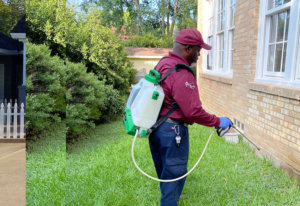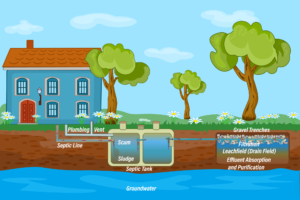Pest control is the process of managing unwanted organisms. It prevents or eliminates organisms that harm desirable plants and animals.
Several simple steps can minimize the need for pesticides. For example, keep food in containers with tight-fitting lids and remove trash regularly. It is also important to declutter areas, as pests are attracted to clutter where they can breed and hide. Click the https://facilitypestcontrol.com/ to learn more.

If you prevent pests from entering your home in the first place, they will never have a chance to cause damage. You can take several preventive measures to minimize the risk of infestations, including using screens on windows and doors, placing bug zappers in common areas, and keeping trash cans closed and disposed of regularly. Also, fixing leaky pipes and preventing moisture buildup in rooms will keep pests at bay.
Generally, pests enter homes in search of food or water. In addition, many pests are known to cause health problems in humans. For example, rodents like rats and mice can trigger diseases such as Plague, Hantavirus Pulmonary Syndrome, Lassa Fever, Salmonellosis, and Leptospirosis. They can also contaminate foods, destroy furniture, and chew through walls and wiring. Pests like ants, beetles, cockroaches, and termites can also trigger allergies and asthma attacks.
In order to avoid pest problems, it’s important to make your home as unattractive as possible. In order to do this, you need to remove all the things that attract them. This includes keeping your trash cans closed and avoiding leaving food scraps around the house. You should also keep wood piles away from the house, trim any trees or shrubs that could provide pests with a highway to your residence, and keep all clutter at bay.
Pests often enter a building through cracks or holes, so it is important to inspect your property for these entry points on a regular basis. If you find any, make sure to patch or seal them immediately. This will prevent the spread of pests and help you avoid costly repairs.
In addition to reducing the risk of pests entering your property, preventive measures also help reduce the need for chemical pesticides, which can harm human and animal life. This combination of prevention and reduced-risk treatment methods is called Integrated Pest Management. This type of pest control can be done on a commercial or residential scale and involves monitoring, baiting, and trapping. In addition, it requires the use of a variety of techniques, including fumigation and heat or freezing treatments.
Suppression
Pests are organisms that interfere with human activities. They may cause physical damage or contamination of foods, products and services in residential homes, retail and food preparation environments, schools, office buildings hea,lth care, hospitality, and construction sites. Some pests spread diseases (e.g., salmonellosis and intestinal worms) or pose a hazard to public health by biting or carrying disease-causing pathogens, such as bacteria and parasites.
There are several ways to suppress pests without the use of chemicals. Good sanitation, removing weeds and infested debris, watering and fertilizing properly, growing competitive plants, and soil solarization can all reduce pest problems. Physical control methods such as traps and barriers, tillage, composting, mulches, steam sterilization of soil, and radiation can also help reduce pest populations.
Some pests are migratory or cyclical and require periodic monitoring for surveillance and control. Others are continuous and need routine preventive controls. The pests that require most management are those that can affect human health or welfare, and include insects (e.g., cockroaches, termites and mosquitoes), rodents (e.g., rats and mice), weeds and other vertebrates (e.g., ragwort and thistles).
Chemicals can be used to kill or deter many pests. Most pesticides are very toxic to natural enemies and other animals. When used with caution, however, low-impact pesticides can be effective. The timing and location of application must be carefully considered to minimize contact between the natural enemy and the pest and to avoid susceptible life stages. Spot treatments and alternating strips of treatment can be helpful in reducing the impact on natural enemies.
Some pests are not naturally controlled by any nonchemical means and must be eradicated using chemical controls. This is most common in outdoor pest control situations, but is occasionally attempted for indoor pests, such as Mediterranean fruit fly and gypsy moth, and can be difficult, even with a well-designed control strategy. Eradication strategies must consider the environmental impact of the pest and its habitat, as well as the economics of the area where the pest is present. It is also important to evaluate the success of any suppression tactics.
Eradication
Many pests can be controlled with physical, biological, or chemical means. The key is threshold-based decision making: Is the pest causing significant damage and should it be controlled? Thresholds vary between pest species and between locations, so careful monitoring is critical. For example, a few wasps flying around the house are annoying but probably not harmful, while a nest in the roof is worth finding and removing.
Flying pests include mosquitoes, certain bees and wasps, hornets, and termite swarmers. These pests pose a risk to human health, as they can transmit diseases such as malaria and West Nile virus. They also contaminate food and water supplies and can cause structural damage to buildings.
Crawling pests include rodents, arachnoids, and insects such as millipedes, earwigs, beetles, and cockroaches. They contaminate food, contaminate soil, and can cause disease in humans, animals, and plants.
Biological pest control uses natural enemies to eliminate the unwanted organisms. This may involve releasing predators, parasites, or pathogens to reduce the population of pests. The advantage of using this approach is that it can be used without the use of chemicals, reducing the danger to people and the environment. However, there is a lag between the introduction of enemies and their impact on the pest population.
Chemical pest control uses synthetic chemicals to kill the unwanted organisms. Several types of chemicals are available, including insecticides and fungicides. Pesticides are generally applied by spraying or dusting. Some pesticides leave toxic residues that can harm plants and pets, so proper labeling is important. Also, pesticides can sometimes be ineffective due to the development of resistant organisms or to conditions not being right for their use.
Alternatives to chemical pest control include planting flowers that attract beneficial insects and repel harmful ones, cleaning and storing food in sealed containers or the refrigerator, sealing cracks around doors and windows, and maintaining clean, debris-free spaces inside and outside the house. Some of these methods can be very time-consuming, while others require expert knowledge and a bit of experimentation. Nevertheless, they are a good option for people who prefer not to use chemicals.
Monitoring
As the basis of any pest control program, effective monitoring is essential. This is accomplished through scouting and checking for pests and their damage. Scouting means going out into the facility regularly to look for insects, and it can be done with a flashlight or a mirror with a telescoping handle to allow you to check behind equipment and in tight spaces. Regular monitoring also includes placing insect sticky traps or fly lights and using insect pheromones to determine the type and number of insects present.
The scouting and monitoring process also helps you identify the action threshold, or the point at which pest populations or environmental conditions require that you initiate control tactics. Threshold levels can be set by regulations, such as food safety codes and standards, or they can be established in the workplace based on best practices and pest management principles.
Once you’ve identified the type of pest and how it entered your food processing environment, it’s important to figure out what’s attracting it to your facility. Is it moisture accumulation, odors, or a food source? It might be a specific raw material such as wheat, barley, or rice, or it could be a general environmental condition such as open doors and windows.
An integrated pest management (IPM) program, for example, uses current and comprehensive information about a given pest to decide on the best combination of chemical and physical controls to eliminate it in a manner that minimizes damage to people or the environment. The first step in IPM is to identify the pest so that the appropriate monitoring and scouting procedures can be developed.
In addition, a Pest Sightings Log should be maintained and a record of the frequency and location of pest sightings can help identify hotspots and guide the placement of monitoring devices and traps. In addition, hand tools such as screwdrivers, pliers and caulking guns should be kept on hand to allow employees to quickly seal gaps or reinforce barriers to entry. This is a simple but effective way to keep pests out of a facility.







